Is Too Much Potash Bad For Garden Soil
- Home
- Crop production
- Nutrient management
- Phosphorus and Potassium
- Potassium for crop production
Potassium (K) is an essential nutrient for plant growth. It's classified as a macronutrient because plants take up large quantities of K during their life cycle.
Minnesota soils can supply some K for crop production, but when the supply from the soil isn't adequate, a fertilizer program must supply the K.
Here, we'll give you a basic understanding of K, including plants' K nutrition, how it reacts in soils, its function in plants and its role in efficient crop production. In addition, you'll find information about soil tests, K sources, predicting potash needs and effectively applying K to your fields.
Role in plant growth
Potassium is associated with the movement of water, nutrients and carbohydrates in plant tissue. It's involved with enzyme activation within the plant, which affects protein, starch and adenosine triphosphate (ATP) production. The production of ATP can regulate the rate of photosynthesis.
Potassium also helps regulate the opening and closing of the stomata, which regulates the exchange of water vapor, oxygen and carbon dioxide. If K is deficient or not supplied in adequate amounts, it stunts plant growth and reduces yield.
For perennial crops such as alfalfa, potassium plays a role in stand persistence through the winter. Other roles of K include:
-
Increases root growth and improves drought resistance.
-
Maintains turgor; reduces water loss and wilting.
-
Aids in photosynthesis and food formation.
-
Reduces respiration, preventing energy losses.
-
Enhances translocation of sugars and starch.
-
Produces grain rich in starch.
-
Increases plants' protein content.
-
Builds cellulose and reduces lodging.
-
Helps retard crop diseases.
Potassium in soils
The total K content of soils frequently exceeds 20,000 ppm (parts per million). While the supply of total K in soils is quite large, relatively small amounts are available for plant growth at any one time. That's because nearly all of this K is in the structural component of soil minerals and isn't available for plant growth.
The amount of K supplied by soils varies due to large differences in soil parent materials and the effect weathering has on these materials. Therefore, the need for K in a fertilizer program varies across the United States.
Three forms of K – unavailable, slowly available or fixed and readily available or exchangeable – exist in an equilibrium in the soil system. Below, we describe these forms and their relationship to one another. Figure 1 also illustrates the general relationship among these forms.

This form of K is thought to be trapped between layers of clay minerals and is frequently referred to as being fixed. Other things to note about slowly available K:
-
Growing plants cannot use much of it during a single growing season.
-
It isn't measured by routine soil-testing procedures.
-
It can serve as a reservoir for readily available K.
-
While some of it can be released for plant use during a growing season, some of it can also be fixed between clay layers and, thus, converted into slowly available K (see Figure 1).
-
The amount of it varies with the dominating type of clay in the soil.
Variances among Minnesota clay types
Montmorillonite clays are dominant in many central and western Minnesota soils. These clays fix K when soils become dry because K is trapped between the layers in the clay mineral. When the soil gets wet, this K is released.
Illite clays are dominant in most southeastern Minnesota soils. These clays also fix K between layers when they become dry, but they don't release all of the fixed K when the soil gets wet. This fixation without release causes problems when managing potash fertilizers for crop production.
Potassium that's considered readily available for plant growth is potassium that is:
-
Dissolved in soil water (water soluble).
-
Held on clay particles' exchange sites, which are found on the surface of clay particles. Called exchangeable K, this is the form of K measured by the routine soil testing procedure.
Plants readily absorb the K dissolved in the soil water. As soon as the soil water's K concentration drops, additional K is released into the soil solution from the K attached to the clay minerals. The K attached to clay minerals' exchange sites is more readily available for plant growth than the K trapped between layers of clay minerals.
The relationships among slowly available K, exchangeable K and water-soluble K are summarized below.

Notice that when the arrows go in both directions, one form of K is converted to another. Factors that affect the conversion rate include root uptake, fertilizer K applied, soil moisture and soil temperature.
Plant uptake: Key factors
Several factors affect potassium uptake by plants, including soil moisture, soil aeration and oxygen level, soil temperature and tillage system.
|
Higher soil moisture usually means greater K availability. Increasing soil moisture increases K's movement to plant roots and enhances availability. Research has generally shown more responses to K fertilization in dry years.
Air is necessary for root respiration and K uptake. Root activity and subsequent K uptake decrease as soil moisture content increases to saturation. Oxygen levels are very low in saturated soils.
Root activity, plant functions and physiological processes all increase as soil temperature increases. And increased physiological activity leads to increased K uptake.
The optimum soil temperature for uptake is 60 to 80 degrees Fahrenheit. Potassium uptake reduces at low soil temperatures.
Availability of soil K reduces in no-till and ridge-till planting systems. The exact cause of this reduction isn't known, although research results point to restricted root growth combined with a restricted distribution of roots in the soil.
Symptoms of potassium deficiency
Some crops exhibit characteristic deficiency symptoms when adequate amounts of K aren't available for growth and development. Potassium is mobile in plants, and will move from lower to upper leaves.
|
For corn, the margins of the lower leaves turn brown (Figure 2). This development of dead tissue is accompanied by a striped appearance in the rest of the leaf. The entire leaf has a very distinct light green appearance when viewed from a distance. The striping can be easily confused with deficiency symptoms for sulfur (S), magnesium (Mg) and zinc (Zn).
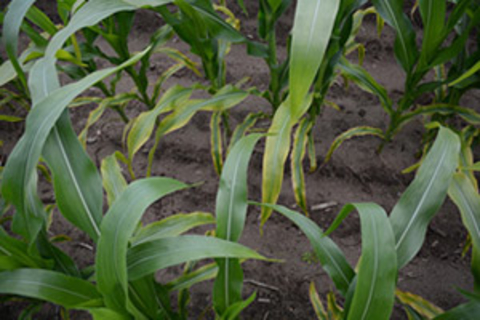
For soybean, the margins of the leaflets turn light green to yellow when K is deficient (Figure 3). Deficiency symptoms first appear on the lower leaves, as with corn. With maturity, deficiency symptoms expand to leaves closer to the top of the canopy.
It's not uncommon to find K deficiency symptoms near the plant tops in isolated field areas with intense soybean aphid pressure. In this case, the deficiency isn't necessarily related to a deficiency of K in the soil.
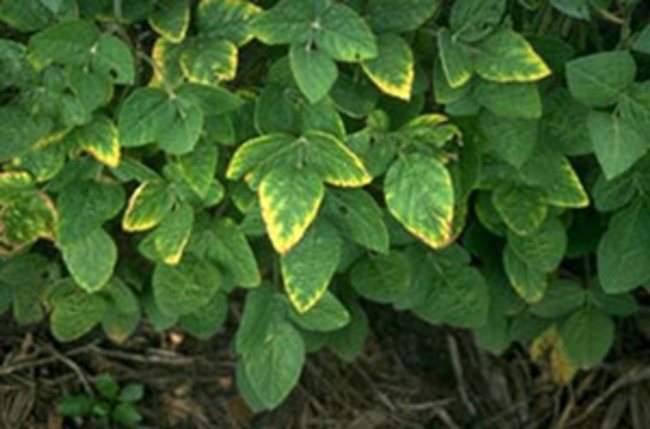
Yellow or white spots on the margins of the leaflets (Figure 4) characterize potassium deficiency in alfalfa. Symptoms first appear on the older plant tissue. Potassium deficiency in alfalfa can be easily confused with damage caused by the potato leafhopper.
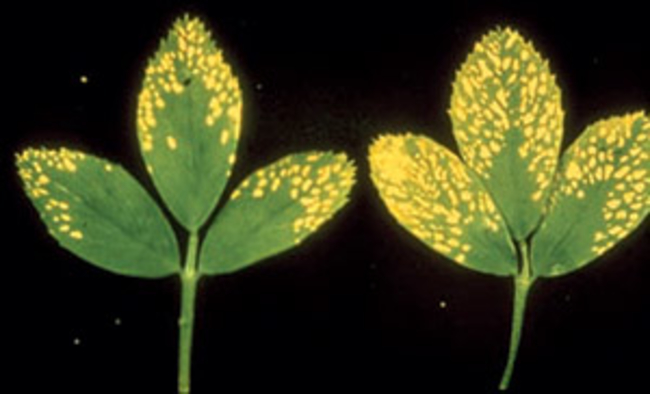
Potassium deficiency in potato occurs as scorching of the leaflet margins, which first occurs on the older leaves (Figure 5 and 6).
You can usually first notice symptoms during tuber bulking (mid-July), as the tuber is a strong sink for potassium. Potassium-deficient potato vines will die back prematurely, which can often be confused with diseases causing vine death.
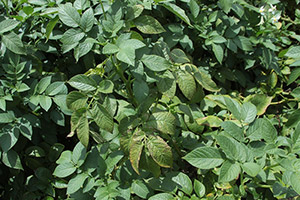
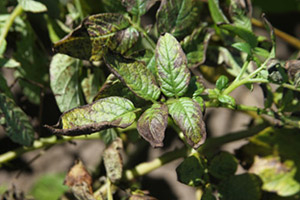
Predicting potash needs
You can monitor K status of soils with plant analysis and routine soil testing.
Soil testing is the most reliable predictor of a fertilizer program's need for potash. Plant analysis can confirm a suspected deficiency indicated by visual symptoms or routinely monitor the effects of a chosen fertilizer program.
|
Table 1: Sufficiency levels of potassium for major agronomic crops, vegetables and fruit grown in Minnesota
If amounts of K in the root zone are more than enough to meet crop needs, K will be absorbed by plants in amounts higher than required for optimum yield. This can lead to higher-than-normal concentrations of K in plant tissue and is referred to as luxury consumption. Luxury consumption has no known negative effect on plant growth.
Soil tests: Soil sample drying's effect on results
Soil testing labs commonly air dry soil samples prior to analysis. Drying soils high in clay can affect the amount of K extracted.
|
If K is fixed by clay, the soil test will extract less K and underestimate the available K, leading to the overapplication of potash fertilizer. Similarly, with clays that release K, availability tends to be overestimated and fertilizer needs underestimated.
Influencing factors
Factors that determine whether K is fixed or released:
-
The type of clay that dominates the soil clay fraction.
-
The soil test K level.
-
The native level of K available from parent material.
-
Recent K fertilizer applications.
Soil in Minnesota
Soils in Minnesota contain a mixture of clays, with smectite and illite being the most abundant clay types. Iron is a structural component of clay minerals, and reducing Fe<sup>3</sup>+ to Fe<sup>2</sup>+ can affect fixation and release of K.
As Fe<sup>3</sup>+ is reduced, K can be trapped (fixed) between clay layers for smectite and K will be released from illite. As soils get wet and dry off, the two types of clays will affect the availability of K to the crop.
Figure 7 gives examples of how drying various soils prior to analysis affects the amount of K extracted. Soil samples were taken from a silt loam soil in Red Wing, a loam soil in Rochester and Lamberton and loamy sand in Becker.
In Rochester and Red Wing, the moist K test extracted more K than the air-dried test. The moist K test extracted more K when the rate of K applied increased.
The two tests were similar for the sandy soil in Becker and when no K was applied in Red Wing. In Lamberton, the moist K test extracted less K than the air-dried test when 100 pounds of K<sub>2</sub>O or less was applied.
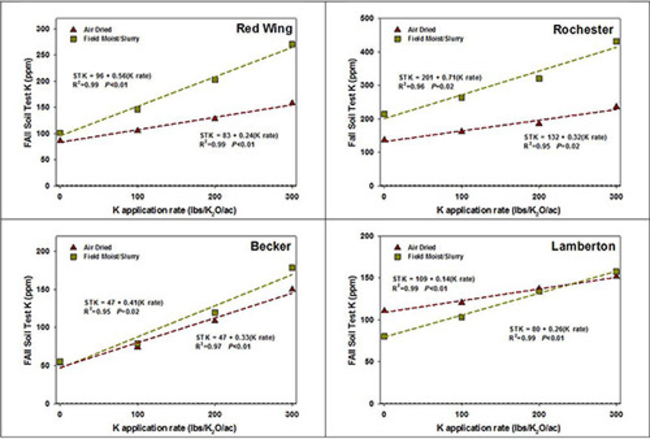
The effect of drying on the K soil test can make it difficult to assess where a deficiency may occur. No fertilizer is suggested when the air-dry K test is above 160 ppm. Uncertainty in whether a release of fixation occurs may change how to interpret this critical level.
Amounts of K extracted and soil test results
Figure 8 summarizes the relationship between the amounts of K extracted on moist samples versus the difference between K extracted with ammonium acetate by the moist test versus the conventional air-dried test.
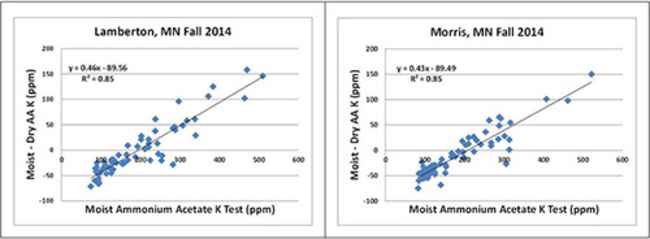
Data suggests the moist test will extract less K than the air-dry test when the moist soil test is less than 200 ppm, and will extract more K when it exceeds 200 ppm.
If overestimation of K is likely for your soil, you may want to use a critical level of 200 ppm for build or maintenance purposes. This helps reduce the risk of a yield reduction due to overestimating available K by air drying soil samples.
The moist K test uses the same chemical extraction as the conventional air-dried test, but should be considered a separate test. Do not use soil test interpretation classes for the air-dried test in Minnesota for the moist K test.
Sources of potassium
There are a limited number of fertilizer materials that can supply K when needed. Table 3 lists these materials.
Table 3: Common potassium fertilizer sources
-
Potassium chloride is the most common K source used in Minnesota.
-
Red, pink and white forms are available. These materials are equivalent as sources of K.
-
The color in 0-0-60 is due to iron impurities that don't affect the availability of K for crop growth.
-
Most potassium chloride used in the United States is mined from underground deposits in Saskatchewan, although some are mined in the western United States.
-
Can be used to supply sulfur in addition to potassium.
-
Often used for potatoes if low specific gravity is a concern. Studies have shown that potatoes fertilized with potassium chloride have will lower specific gravity compared to those fertilized with potassium sulfate.
-
Potassium-magnesium sulfate is a good source of K when there's also a need for magnesium in a fertilizer program. Consider this for fertilizing corn, alfalfa and small grains grown on sandy soils.
-
The cost of potassium nitrate and potassium sulfate is usually higher, so use in Minnesota is very limited.
-
Use this liquid fertilizer for fertigation or foliar K applications.
-
It may be phytotoxic if used as a popup fertilizer, especially in low soil moisture conditions.
-
Don't apply as a foliar application if temperatures are above 90 degrees Fahrenheit.
-
Potassium nitrate is a readily available source of K, but is primarily used for high-value crops because of its cost.
-
The K content of manure varies with animal type, feed ration, storage and handling practices.
-
Analyze manure to determine how much K was applied.
-
Consider the total amount of K in manure to be readily available, as K isn't a structural component of organic molecules.
Applying and managing potassium
Suggested management practices for K vary with each crop.
You can apply potassium fertilizer either in the fall or spring for most soils in Minnesota. Sandy soils with a low cation exchange capacity have a low ability to hold K. Consider potassium to be partially mobile on sandy soils and apply it closer to the time of planting.
|
There's a higher probability of successful establishment of perennial crops such as alfalfa and grasses if the soil test for K is in the medium range or higher.
For these crops, the best strategy is to apply potash fertilizers before seeding, followed by annual top-dress applications. Base the annual applications on the results of routine soil tests for K.
Recent studies for corn have shown a single pre-plant application of K to be sufficient for corn grown on sandy soils compared to a split application of K pre-plant and when the corn is 12 inches tall.
You can apply any potash needed for corn and small grain production in a band near the seed at planting, or broadcast and incorporated before planting. When applying in a band, you can cut the recommended potash broadcast rate in half. This doesn't reduce yield, but does reduce fertilizer costs.
Table 4 illustrates the effectiveness of banded potash for corn production.
Banded application of potash is essential for corn grown in ridge-till and no-till production systems. A rate of 40 to 50 pounds of K<sub>2</sub>O per acre is suggested, even though the soil test for K may be in the high or very high range.
Table 4: Effectiveness of potash fertilizer on corn production in Goodhue County
For soybeans, broadcast applications of potash fertilizer incorporated before planting are most effective. Banding fertilizer for the soybean crop will increase grain yield in K-deficient soils. Unlike corn and small grains, the greatest soybean yield increases are associated with broadcast fertilizer application.
Applying K<sub>2</sub>O in a band in the fall after soybean harvest is a popular management practice for those using reduced tillage in the corn-soybean rotation.
Liquid forms of potassium
Liquid forms of potassium are available for in-furrow application as a starter fertilizer. These forms of fertilizer are manufactured with either potassium chloride (KCl) or potassium hydroxide (KOH).
|
Fertilizer sources containing KCl pose a greater risk for stand damage due to salts in solution.
If a fertilizer source contains KCl, apply no more than 10 pounds of N + K<sub>2</sub>O in loamy soils and 4 pounds of N + K<sub>2</sub>O in sandy soils.
Fertilizers containing KOH are safer for seed placement as they form potassium-phosphate compounds that don't contribute to the fertilizer's salt content. Low-salt fertilizer sources manufactured with KOH cost more and may contain a very low concentration of K.
Applying fertilizer on the corn seed as an in-furrow application cannot supply all the needed K in a K-responsive soil.
Potassium thiosulfate is a liquid fertilizer containing K and S. Applying fertilizer containing thiosulfate can negatively impact seedling emergence and isn't suggested for in-furrow application.
Daniel E. Kaiser, Extension nutrient management specialist and Carl J. Rosen, Extension nutrient management specialist
Reviewed in 2018
Is Too Much Potash Bad For Garden Soil
Source: https://extension.umn.edu/phosphorus-and-potassium/potassium-crop-production
Posted by: phillipsnotat1938.blogspot.com

0 Response to "Is Too Much Potash Bad For Garden Soil"
Post a Comment